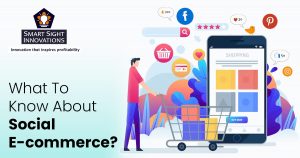 As online shopping is going social, its features are emerging across many platforms, creating new opportunities for brands. Browsing and shopping directly on social media networks is an essential aspect of e-commerce.
As online shopping is going social, its features are emerging across many platforms, creating new opportunities for brands. Browsing and shopping directly on social media networks is an essential aspect of e-commerce.
This innovative new purchasing method is expected to grow rapidly as consumers can explore products and complete transactions through social media itself. In 2021 alone, goods and services purchased through social e-commerce channels surpassed $30 billion. By 2025, this amount is expected to increase to around $80 billion.
Social E-commerce and Its Types
Social e-commerce uses social networks to help in buying and selling goods and services. It includes online forums, social networking sites, social media advertising, social media shares and stores to buy and sell goods. Social e-commerce is where social media and shopping meet which is a logical evolution, considering how powerful social media has become over the past few years and the variety of opportunities it offers.
Social media provides businesses with numerous opportunities to boost sales. Below are some types of social e-commerce.
-
Social network-driven sales
This is where consumers purchase a product when referred via social media websites like Facebook or Twitter. The Facebook “shop” tab function is an excellent illustration of this.
-
Platforms for peer-to-peer sales
These platforms provide a local marketplace where people can trade goods and services. Buying and selling on eBay is an example of peer-to-peer sales.
-
Social shopping
Social shopping refers to online shopping with social features, like a chat option for people to discuss ideas and give suggestions. Examples of this include Listia and Go Try It On.
-
Picklist sites
These platforms allow users to create and exchange product lists, which other users can subsequently use to make purchases. Lyst and The Fancy are examples of this method.
-
Group buying and daily deals
Here, the websites offer customers the opportunity to buy something at a discounted price if enough people agree to do so. Groupon is one of the best examples of this.
-
Participatory commerce
In this type of social e-commerce, consumers through voting and funding, participate in the production process. These are also known as crowdfunding or crowdsourcing and Cut On Your Bias and Threadless are the best examples.
-
User review websites
The sales under this type of social e-commerce are related to service and product reviews. Amazon is an excellent example where customers can view the opinion of other customers who have purchased the same item.
How Does Social E-commerce Work and Why Is It Important?
Social e-commerce makes use of the enormous global user base of social media platforms. This gives brands access to a larger audience than would be possible to advertise. Users can find and explore brands, products and services or add products to their shopping carts, all without leaving the social network.
It can involve both the use of native shopping options such as Facebook and Instagram or e-commerce connections such as browsing a product catalog on a social platform. Social e-commerce gives consumers the option to proceed directly to checkout without leaving the social network.
This helps speed up the process and lowers the possibility of shopping cart abandonment. It also opens up possibilities for consumer brands to begin a journey that is far more engaging and entertaining.
Leading businesses, for instance, are collaborating with platforms like TikTok to create new connections with customers, moving away from traditional advertising tactics and towards entertaining and engaging content. This information can also be utilized to highlight distinctive product features.
Benefits of Social E-commerce
With billions of people actively using social media, it has become a profitable market for numerous firms. Businesses understand the importance of including social e-commerce in their sales and marketing strategies to stay competitive in the digital world.
Social e-commerce can boost brand recognition, enhance client satisfaction and revenue when used effectively. Some of its benefits are:
-
Wide market base
Globally, there were more than 3.6 billion social media users in 2020 and by 2025, that figure is predicted to rise to 4.4 billion. As more individuals begin to conduct their online purchases through social media, you have a great opportunity to expose your goods to a wider audience and expand it quickly.
You can capitalize on this buying behavior by making it as easy and clear as possible for customers to complete their transactions straight through their social media platforms.
-
Presence and brand awareness
By regular content and influencer marketing, social e-commerce offers you an excellent opportunity to build brand awareness and maintain customer attention. According to a 2021 survey, the shopping decisions of social media users in the US were motivated by influencer posts in 53% of cases. Therefore influencer marketing might be a worthwhile investment if you’re searching for strategies to raise brand awareness.
-
Reaching the target audience
As the majority of your clients are already using social media it presents you with the ideal chance to share your brand voice through original content and communicate with current customers in a more genuine way. Researching your clients’ demographics, determining what they enjoy and dislike and possibly even speaking with them directly to have a deeper understanding of how you can best serve them, will help you reach your target audience.
Many social media platforms also offer analytics features that let you monitor the user’s social and purchasing trends. This will help you tailor your content and products to your target audience.
-
Convenient shopping experience
You can streamline the purchasing process by improving customer experience. This includes removing extra steps by using features like the buy button and in-app checkout. By providing a simple purchasing process you can reduce the risk of customers losing interest and leaving your page and boost revenues.
-
Generate social data
Social e-commerce comes with in-built social proof largely through comments, likes, follows and shares. Through these, brands can create a positive feedback loop that can persuade customers to purchase. Giving customers incentives like coupon codes and discounts on sharing their information, is one practical strategy to develop social proof.
Best Platforms for Social E-commerce
The expansion of social media and shopping features of content-creation platforms is driving the adoption of social e-commerce globally. Platforms are now able to execute transactions, gaining access to first-party customer data and enhancing their capacity to provide value to advertisers.
Social e-commerce offers businesses a brand-new source of income, which is why they’re a vital aspect of e-commerce development. Some of the best social e-commerce platforms are:
-
Facebook
The Facebook Shop is accessible from the Facebook page itself. The Facebook Shop tab displays products depending on user preferences. Customers can make a purchase on your website or in the app after discovering products. Sellers interact with the customers through Messenger to answer issues, provide support and more.
-
Instagram
Instagram Shopping is connected to Facebook Shop, wherein the users have to link both business profiles to upload a product catalog or to create one.
-
Pinterest
Customers need to go to a landing page that is particular to the product to purchase as the Products Pins are not direct social e-commerce tools. If you’re using other e-commerce platforms, you can still set up Product Pins manually.
-
TikTok
TikTok is evolving into much more than just a platform for sharing quick videos. With the addition of shoppable posts, live stream shopping features and influencer marketing opportunities, TikTok has become a worthy social e-commerce platform. Users can add the Shopping tab to their business profile and sync it to the product catalog, which will help make purchases directly from the app.
By using social e-commerce platforms, many brands have been able to increase sales and provide a seamless online buying experience. Brands like Skullcandy, LARQ, Burrow, The Tiny Tassel, Patagonia, Target, etc. have gained tremendously by adopting social e-commerce strategies. Businesses must have a clear plan and use the appropriate channels to reach their targets to be successful in social e-commerce.














